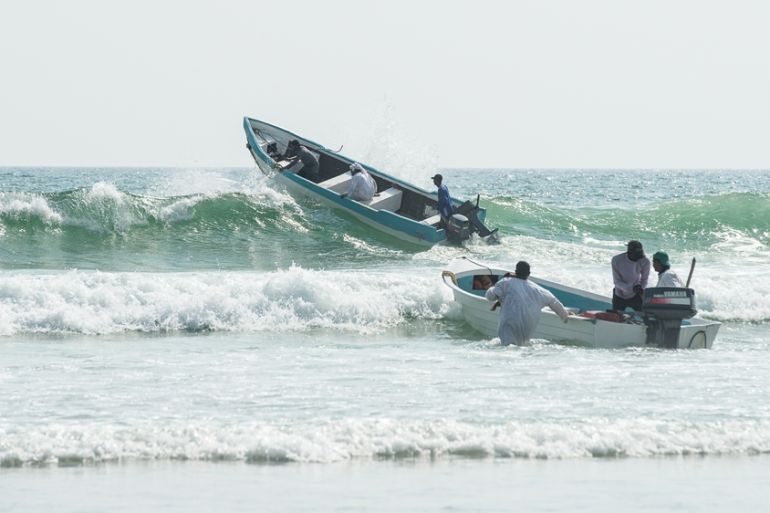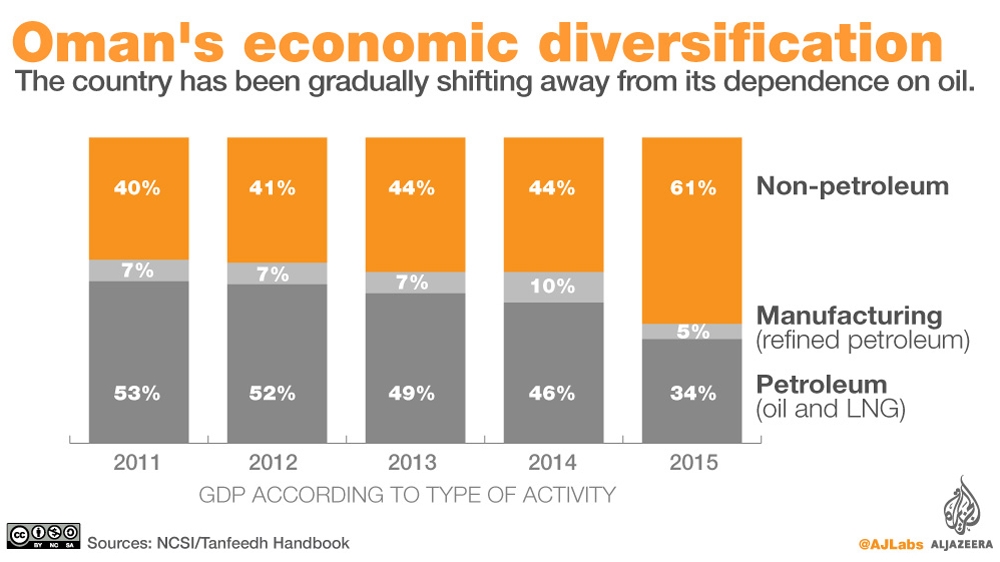Oman moves closer to a post-oil economy
Ambitious plan to diversify the country’s revenue streams focuses on sectors such as manufacturing and tourism.

Muscat, Oman – The future of Oman, situated along a vast stretch of coastline reaching the strategic Strait of Hormuz, is linked to the sea – and the country’s ability to leverage this connection will be key to its economic development in the years ahead.
2018 marks the middle of a five-year diversification strategy that builds on Oman’s long-term vision to shift from an oil-based economy towards other critical sectors, including manufacturing, logistics, tourism, fisheries and mining.
Keep reading
list of 4 itemsQatar emir condemns ‘genocide’ in Gaza, urges ceasefire at GCC summit
‘Enduring commitment’: Key takeaways from US-GCC joint statement
Analysis: Efforts to end Assad isolation gather speed after quake
In an era of low oil prices, Oman – which has the lowest GDP per capita among the Gulf Cooperation Council (GCC) countries and an unemployment rate surpassing 17 percent – wants to refashion itself as a hub for shipping and industry. Facilities such as the special economic zone at Duqm, established in 2011 with a goal of becoming a commercial powerhouse, will play a significant role in this transition.
But how realistic is Oman’s diversification plan, and what obstacles could the Gulf nation face in the years ahead?
“We are aware that we live in a very critical area of the Middle East … [Oman] is like an island in a sea with a lot of challenges happening,” Talal Sulaiman al-Rahbi, the deputy secretary-general of Oman’s Supreme Council for Planning and the architect of the country’s economic diversification plan, told Al Jazeera.
“We are looking first into reducing the dependence on oil for the national budget, and also to diversify the economy and start other clusters of industries … in addition, increasing job opportunities in the private sector, away from government jobs. [These] are being looked at as key things to achieve.”
‘Unique competitive advantage’
According to the Tanfeedh (“Implementation”) handbook for Oman’s National Program for Enhancing Economic Diversification, published earlier this year, non-oil activities are forecast to grow at 4.3 percent annually between 2016 and 2020, while oil-related activities at constant prices will increase at just 0.2 percent annually.
“Economic diversification is considered a strategic objective which will lead to economic growth in light of the global economic conditions … The diversity of its natural resources presents the Sultanate a unique competitive advantage in regional and global markets, as well as an opportunity to achieve its economic diversification objectives,” the handbook notes.
An emphasis on the identified non-oil sectors, such as tourism and fisheries, will result in a decline in the contribution of oil to Oman’s GDP from 44 percent in 2011-2015 to 30 percent by 2020, officials project.
![According to Oman's economic diversification plan, the fisheries sector is expected to achieve a growth rate of 6.5 percent annually by 2020 [Wojtek Arciszewski/Al Jazeera]](/wp-content/uploads/2017/12/1fcee304073c42489bec3d65d783d9ea_18.jpeg)
At the same time, the state aims to increase the contributions of manufacturing, tourism and logistics to its GDP from 4.9 billion Omani riyals ($12.7bn) in 2015 to 6.6 billion by the end of 2020, while creating at least 30,000 new job opportunities for Omanis.
This entails a diverse array of projects – everything from building an ammonium plant, to manufacturing scaffolding locally, to planting a million date palm trees, to privatising the management of nature and heritage sites, to strengthening academic and professional training programmes to ensure Omanis are better equipped for the workforce.
Education is a critical part of this equation, as many citizens lack the type of technical knowledge needed to kick-start certain industries, noted Marcus Chenevix, a MENA analyst with the London-based economics consultancy TS Lombard.
“Oman has a great deal of potential to diversify, probably in many ways more than its neighbours, especially in terms of tourism and in terms of the natural resources that Oman has available – things like access to an enormous fishery,” he told Al Jazeera.
However, the focus on areas such as manufacturing may be problematic, as the country “has no real institutional memory of having that kind of industry and it’s very hard to develop that from scratch”, Chenevix said.
Job creation
Oman has experienced massive growth since Sultan Qaboos bin Said Al Said came to power nearly half a century ago. His predecessor left the country stunted, but in the decades that followed, Qaboos used oil revenues to build schools, roads, hospitals and other vital infrastructure.
Today, protracted low oil prices are weighing on Oman’s economy, as deficits remain large and real GDP growth has slowed to an estimated 2.2 percent in 2016 from 5.7 percent in 2015, according to the World Bank. “However, growth is expected to pick up in 2018 as Oman pins hopes for its economic diversification plan on the fisheries and tourism sectors,” noted the organisation’s April economic outlook for the GCC.
The expected boost in gas production at the Khazzan field next year will also help uplift the economy.
“The problem is not about the creation of jobs – it’s how to create jobs that are good for the locals, and also how to produce outcomes of the education system that fit the job market,” Rahbi said, citing efforts “to close the gap between the supply of graduates and the demand of the local market … [including] getting private sector jobs and also starting their own businesses”.

Salalah businessman Salim Said Bahid al-Mashikhi, who has interests in the construction, power and restaurant industries, says that despite the fiscal challenges facing Oman, he is optimistic about the country’s future.
“The economy in Oman, in general, is affected because of the low price of oil, but the government has tried its best to address this problem … [An increasing number of] foreigners and visitors like to come to Oman and spend money and invest,” Mashikhi told Al Jazeera, highlighting the value of diversification.
“It is very important for the country to try to get another income, not to depend only on oil and gas,” he said. “What’s happening from the crisis of low oil prices should be a warning to go for other solutions.”
Salim Aday al-Mamari, Oman’s director-general of tourism promotion, believes that the state’s push to draw new visitors will be an important facet of this. Oman aims to attract 2.7 million visitors annually by 2020, up from 1.9 million in 2015, and there are a wealth of heritage and nature sites that can be leveraged to help make that happen.
“Oman has lots of beautiful places that can be visited and can be introduced to international tourists,” Mamari told Al Jazeera. “This sector can play an important role in the economy of the nation by contributing jobs and by introducing Oman to international markets.”
Follow Megan O’Toole on Twitter: @megan_otoole
!['Economic diversification is considered a strategic objective which will lead to economic growth in light of the global economic conditions' [Wojtek Arciszewski/Al Jazeera]](/wp-content/uploads/2017/12/9da1966395264cbf841472f0f6a3f265_18.jpeg)